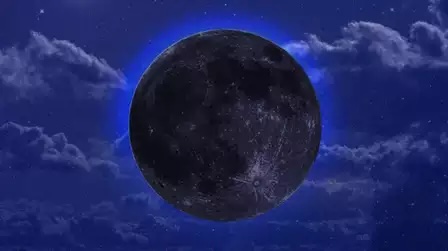December 2024 will feature a rare celestial event: a “black moon,” the term used for the second new moon occurring within a single calendar month. While “black moon” isn’t an official astronomical term—similar to how two full moons in one month are dubbed a “blue moon”—it’s commonly used to describe this lunar rarity.
The New Moon

A new moon happens when the sun and moon align at the same celestial longitude, a configuration known as conjunction. During this phase, the moon becomes invisible from Earth because its illuminated side faces away from us. The exception occurs during a solar eclipse, when the moon briefly reveals itself as it passes in front of the sun.
For astronomers—both professional and amateur—new moon nights offer prime stargazing conditions. With no bright moonlight to obscure the view, faint celestial objects become more visible. This effect is often enhanced during winter in much of North America, where drier air provides clearer, sharper views through telescopes.
A Mercury-Moon Conjunction: A Celestial Encounter

On December 28th at 11:24 p.m. Eastern Time, the moon and Mercury aligned in a celestial conjunction, appearing about 6 degrees apart. While the event wasn’t directly visible from the United States, skywatchers in New York City still caught a glimpse of the two planets in the early morning sky.
On that day, Mercury rose at 5:38 a.m., the sun at 6:48 a.m., and the moon at 5:26 a.m. By 6:15 a.m., both Mercury and the moon were roughly 6 degrees above the eastern horizon, with the moon—a delicate crescent—positioned to the right of Mercury. However, their proximity to the horizon made them challenging to spot.
For a better view of the conjunction, one must head further east. In Cairo, Egypt, for instance, the conjunction occured at 6:24 a.m. local time on December 29th, according to In-the-sky.org. There, Mercury rose at 5:13 a.m., the moon at 5:33 a.m., and sunrise followed at 6:50 a.m. At the time of conjunction, Mercury was 13 degrees above the horizon, while the moon was at 8 degrees, both visible in the southeastern sky.
In Cape Town, viewing the Mercury-Moon conjunction posed an additional challenge due to the early sunrise of the austral summer. The sun rose at 5:36 a.m. local time, meaning the conjunction occured after daylight has already begun.
However, early risers still caught a glimpse before the sky brightened. Mercury rose at 4:12 a.m., and the moon followed at 3:48 a.m. By 5:00 a.m., the pair were approximately 10 degrees above the horizon, with the moon positioned above and slightly to the right of Mercury.
According to the U.S. Naval Observatory, this second new moon will take place on December 30th at 5:27 p.m. ET (2227 GMT), just two days after the waning crescent moon passes close to Mercury in the early morning sky.
Visible Planets During the New Moon: A Global Perspective

Image source: Shutterstock
On the night of the new moon on December 31st, several planets will be visible, offering skywatchers in both hemispheres a celestial treat.
Northern Hemisphere: New York City
- Mercury: Visible in the dawn sky, Mercury rises at 5:45 a.m. Sunrise follows at 7:20 a.m. By 6:45 a.m., Mercury will be about 9 degrees above the southeastern horizon—challenging to spot but possible with a flat horizon and clear skies.
- Venus & Saturn: In the evening sky around 6:00 p.m., Venus and Saturn will shine in the southwest at 22 degrees and 35 degrees above the horizon, respectively. Venus sets at 8:27 p.m., while Saturn follows at 9:57 p.m.
- Jupiter: Look to the eastern sky around 6:00 p.m., where Jupiter will be positioned 43 degrees above the horizon, to the left of Aldebaran, the brightest star in Taurus. The contrast between Jupiter’s pale glow and Aldebaran’s reddish huemakes them easy to identify. Jupiter sets at 5:26 a.m. on December 31st.
- Mars: Rising at 6:07 p.m., Mars will reach about 20 degrees above the eastern horizon by 8:00 p.m. It remains visible until sunrise.
Southern Hemisphere: Buenos Aires
- Mercury: In the predawn hours of December 31st, Mercury rises at 4:18 a.m. By 5:00 a.m., it will be about 7 degrees above the eastern horizon—a similarly low and challenging sight as in the Northern Hemisphere.
- Venus & Saturn: On the evening of December 30th, Venus and Saturn will appear in the western sky, with Venus closer to the horizonand Saturn higher up and slightly northward (right). Venus sets at 10:54 p.m., while Saturn follows at 11:44 p.m.
- Jupiter: Turning towards the northeast, Jupiter will be seen below Aldebaran from mid-southern latitudes. Jupiter sets at 4:00 a.m. on December 31st.
- Mars: Mars rises at 9:42 p.m., but it remains relatively low on the horizon for a while. By 11:30 p.m., it will only be about 18 degrees high in the northeastern sky.
Whether in New York or Buenos Aires, the last night of December offers planetary views across the sky, with Mercury at dawn, Venus and Saturn at dusk, and Jupiter and Mars gracing the night. Clear skies and patience will reward stargazers with a memorable celestial display.
Stars and Constellations in January: A Celestial Guide for Both Hemispheres

Northern Hemisphere: Winter Sky Highlights
In January, the winter constellations dominate the night sky for observers in the Northern Hemisphere, offering some of the most recognizable patterns in astronomy.
- Orion and Taurus: By 6:00 p.m., Orion, the Hunter, rises in the eastern sky. As the sky darkens, Orion’s famous Belt stars become visible. Facing Orion is Taurus, the Bull, positioned higher in the sky. The Hyades star cluster, forming the “face” of the bull, is a striking feature.
- Auriga, the Charioteer: Above Orion’s head lies Auriga. To locate it, follow Orion’s Belt upward to Betelgeuse, the reddish-orange star marking Orion’s shoulder. Continuing nearly straight upward brings you to Aldebaran, another orange star. Jupiter will be to Aldebaran’s left, shining steadily without the twinkle characteristic of stars. Drawing a line through Aldebaran and Jupiter leads to Menkalinan and finally to Capella, a bright yellowish-white star at the heart of Auriga.
- Canis Major & Canis Minor: By 9:00 p.m., Orion’s “hunting dogs”—Canis Major and Canis Minor—rise in the southeast. Canis Major, to Orion’s lower right, features Sirius, the brightest star in the sky. Above Sirius lies Procyon, the brightest star in Canis Minor. Together with Betelgeuse, Sirius, and Procyon form the Winter Triangle, a prominent asterism easily visible even in light-polluted areas.
- Leo the Lion: By 11:00 p.m., Leo the Lion has fully risen. To find Regulus, Leo’s brightest star, start at Sirius, move leftwards past Procyon, and look slightly downward towards the eastern horizon. Regulus marks the base of Leo’s sickle-shaped head and mane, while Denebola, the Lion’s tail, lies farther left. At this hour, Orion stands upright, with the Belt stars forming an east-to-west line. The bright blue-white star Rigel, Orion’s foot, shines brilliantly below the Belt.
- Eridanus, the River: Below and to the right of Rigel lies Cursa, the second-brightest star in Eridanus, the celestial river. While Achernar, the river’s brightest star, isn’t visible north of 33° latitude, observers in the southern U.S. stateslike Florida, Texas, Arizona, and San Diego may catch a glimpse of it.
Southern Hemisphere: Summer Sky Wonders
In the Southern Hemisphere, January skies are dominated by constellations associated with the mythological ship Argo Navis—split into Puppis, Carina, and Vela.
- Orion’s “Upside-Down” Appearance: After twilight ends around 9:00 p.m., Orion appears inverted in the northeastern sky, with the Belt stars above Betelgeuse. Rigel, instead of being Orion’s “foot,” is now seen upward and to the left.
- Eridanus and Achernar: Following Eridanus from Cursa, the river stretches across the sky, reaching Achernar at an impressive 64° altitude in the southeast.
- Canopus and Puppis: A line drawn between Betelgeuse and Sirius, extended southward, points to Canopus, the brightest star in Carina, situated about 47° high in the southeast. Above Canopus lies Puppis, whose seven faint stars form a foot-like pattern.
- Vela and the Southern Cross: To the right of Puppis, you’ll find Vela, a constellation shaped like a ring of stars representing the ship’s sail. Turning further right leads to Crux, the Southern Cross, which appears low on the horizon, rising in the south-southeast. From Buenos Aires, Crux never sets, making it a permanent feature of the southern sky.
Whether observing from north or south, January skies offer breathtaking views filled with iconic constellations and dazzling stars. Clear skies and a bit of patience will reveal the timeless beauty of our celestial neighbors.

